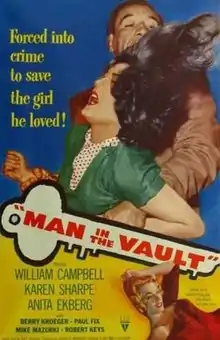Man in the Vault
Man in the Vault is a 1956 film noir about a locksmith, played by William Campbell, who is forced to help gangsters commit a robbery. The screenplay by Burt Kennedy was based on the novel The Lock and the Key by Frank Gruber. The film was the directorial debut of Andrew V. McLaglen.
| Man in the Vault | |
|---|---|
 Film poster | |
| Directed by | Andrew V. McLaglen |
| Produced by | Robert E. Morrison John Wayne (uncredited) |
| Screenplay by | Burt Kennedy |
| Based on | novel The Lock and the Key by Frank Gruber |
| Starring | William Campbell Karen Sharpe Anita Ekberg |
| Music by | Henry Vars |
| Cinematography | William H. Clothier |
Production company | |
| Distributed by | RKO Radio Pictures (theatrical) Paramount Pictures (current) Paramount Home Entertainment (DVD) |
Release date |
|
Running time | 73 minutes |
| Country | United States |
| Language | English |
Plot
The criminal Willis Trent wants to rob the safety deposit box of a crooked Los Angeles businessman, Paul De Camp. He has lawyer Earl Farraday smooth-talk the guy's girlfriend, the two-timing Flo Randall, into revealing the bank box's number.
Now they need a locksmith. A henchman called Herbie is sent to find one. He settles on Tommy Dancer, who works in a bowling alley. Tommy is quickly smitten with Earl's girl Betty Turner but is a law-abiding citizen and rejects an offer of $5,000.
Tommy falls for Betty, taking her to the Hollywood Bowl and learning she comes from a wealthy family. Tommy's attentions to her get him a beating from Louie, another big thug. He is told Betty's face will be disfigured if he refuses to cooperate.
Breaking into the box is no problem, but Tommy thinks he's been double-crossed by Betty and decides to keep the $200,000. He stashes the cash in a locker at the bowling alley. Flo confesses her part in the scheme to De Camp, who goes after Tommy, even hurling bowling balls at him before the cops show up.
Tommy races to save Betty, realizing she's on the level. Trent ends up dead, and Tommy's future is a lock.
Cast
- William Campbell as Tommy Dancer
- Karen Sharpe as Betty Turner
- Anita Ekberg as Flo Randall
- Berry Kroger as Willis Trent
- Paul Fix as Herbie
- James Seay as Paul De Camp
- Mike Mazurki as Louie
- Robert Keys as Earl Farraday
- Nancy Duke as Trent's girlfriend
- Gonzales Gonzales as Pedro
- John Mitchum as Andy (uncredited)
References
- "Man in the Vault: Detail View". American Film Institute. Retrieved June 2, 2014.